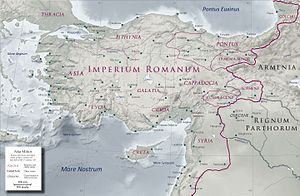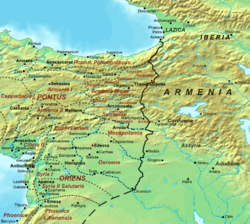Lesser Armenia
This articleneeds additional citations forverification.(January 2023) |
| History ofArmenia |
|---|
 |
| Timeline•Origins•Etymology |
Lesser Armenia(Armenian:Փոքր Հայք,romanized:P’ok’r Hayk’;[1]Latin:Armenia Minor;Ancient Greek:Mικρά Αρμενία,romanized:Mikrá Armenía[2]), also known asArmenia MinorandArmenia Inferior,comprised the Armenian-populated regions primarily to the west and northwest of the ancientKingdom of Armenia(also known as Kingdom of Greater Armenia), on the western side of theEuphrates River.It was also a kingdom, separate from Greater Armenia, from the 2nd century BC to the 1st century AD. The region was later reorganized into theArmeniac Themeunder theByzantine Empire.
Geography[edit]
Lesser Armenia (or Armenia Minor) was the portion of historicArmeniaand theArmenian Highlandslying west and northwest of the riverEuphrates.[2]It received its name to distinguish it from the much larger eastern portion of historic Armenia—Greater Armenia (or Armenia Major).
Early history[edit]

Lesser Armenia corresponded to the location of theLate Bronze AgeHayasa-Azziconfederation, which is thought by some scholars to be the source of the Armenian endonymhayand the original state of the Proto-Armenians.[3]It has been suggested that the epithet "lesser" indicates that this territory was the older homeland of the Armenian people, while "greater" Armenia referred to a territory that was later settled.[3][4]
Lesser Armenia may have formed a part of the territories of theOrontid dynasty,which ruled Armenia first as satraps of theAchaemenid Empireand then as kings.[5]However, there is no clear evidence to support this claim.[5]Lesser Armenia emerged as a separate kingdom after theTreaty of Apameain 188 BC, although the exact origin, size and history of this kingdom are murky.[6]The capital of this kingdom was probably originally atKamakh,but likely moved toNicopolisafter the end of theMithridatic Wars.[6]Lesser Armenia apparently experienced the high point of its territorial expansion during the Orontid period, possibly expanding its borders to theBlack Sea.[5]According toStrabo,it originally had its own royal dynasty.[7]It passed under the control of theKingdom of Pontusin the 1st century BC, during the reign ofMithridates VI Eupator(r. 120 – 63 BC), who built 75 fortresses there.[7]After theRomansdefeated Pontus in theMithridatic Wars,Lesser Armenia became a client kingdom of Rome, who appointed various client kings to rule the kingdom.[7]The last of these wasAristobulus of Chalcisof theHerodian dynasty.[7]In 72 AD, Lesser Armenia was annexed by the Roman Empire and made a part of the larger province ofCappadocia.[8]

Roman and Byzantine Lesser Armenia[edit]
All of Armenia became aRoman provincein AD 114 under Roman emperorTrajan,but Roman Armenia was soon after abandoned by the legions in 118 AD and became a vassal kingdom. Lesser Armenia, however, was generally incorporated by Trajan, together withMeliteneandCataonia,into theprovince of Cappadocia.Lesser Armenia consisted of five districts:Orbalisenein the North; below thatAetulane;Aeretice;thenOrsene;and finallyOrbesine,the most southern. The more southern districts appended to Lesser Armenia were Meleiene, so called from its capital Melitene (modern Malatya) and the following four small districts of ancient Cataonia, namely,Aravene;Lavinianesineor Lavianesine; Cataonia, in the more restricted sense, or the country close uponCiliciasurrounded by mountains; finally,Murianeor Murianune, between Cataonia and Melitene, called likewiseBagadoania.[9]
Lesser Armenia was reunited with the kingdom of Greater Armenia under the Arshakuni kingTiridates IIIin AD 287 until the temporary conquest ofShapur IIin 337.[citation needed]
Then it was formed into a regular province underDiocletian,and in the 4th century, was divided in two provinces: First Armenia (Armenia Prima), which contained most of Lesser Armenia, and Second Armenia (Armenia Secunda) that comprised all the southern tracts which had been added to Lesser Armenia, with the exception of Cataonia, which was incorporated withCappadocia Secunda.[10]
Its population remained Armenian but was being gradually Romanized. Since the 3rd century many Armenian soldiers were in the Roman army: later–in the 4th century–they made up two Roman legions, theLegio I Armeniacaand theLegio II Armeniaca.[citation needed]
In 536, the emperorJustinian Ireorganized the provincial administration, and First and Second Armenia were renamed Second and Third respectively, while some of their territory was split off to the other Armenian provinces.[citation needed]
The borders of the Byzantine part of Armenia were expanded in 591 into Persarmenia, but the region was the focus of decades of warfare between the Byzantines and the Persians (theByzantine-Sassanid Wars) until theArab conquest of Armeniain 639.
After this, the part of Lesser Armenia remaining under Byzantine control (in a lesser extent) became part of the theme ofArmeniakon.
Mongol and Ottoman influence[edit]
After the downfall of Bagratid Armenia in 1045 and resulting subsequent losses of Byzantine Empire in the East after theBattle of Manzikertin 1073, Lesser Armenia fell to theSeljuksand then was part of theMongol Empirefor 92 years and of theOttoman Empirefrom the late 15th century.
Between the 11th and 14th centuries, the term Lesser Armenia (sometimes called "Little Armenia" ) was applied to the Armenian Kingdom of Cilicia, right until the formation ofTurkeyin 1923.
Episcopal sees[edit]
Ancient episcopal sees of the Roman province ofArmenia Prima (I)listed in theAnnuario Pontificioastitular sees:[11]
- Berissa
- Colonia in Armenia(Köylühisar) (Armenian Catholic Church)
- Nicopolis in Armenia
- Pedachtoë (Bedochton, Pedachton)
- Satala in Armenia
- Sebastea(Sivas)
- Sebastopolis in Armenia(Sulusaray)
Ancient episcopal sees of the Roman province ofArmenia Secunda (II)listed in theAnnuario Pontificioastitular sees:[11]
- Arabissus
- Arca in Armenia (Arga)
- Ariarathia(Aziziye)
- Comana Armeniae(Sar or Sarkale)
- Cucusus(Göksun)
- Melitene(Malatya)
- Verissa
For ancient episcopal sees of the Roman province ofArmenia Tertia (III),seeRoman Armenia#Episcopal sees.
Later history[edit]
Lesser Armenia is traditionally considered as part ofWestern Armenia,especially after the acquisition ofEastern Armeniaby theRussian Empirein the aftermath of theRusso-Persian War of 1826-1828.[12]
The Christian Armenian population of Lesser Armenia continued its existence in the area until theArmenian genocideof 1915–23. Some Armenians still live in the area, albeit converted toIslamunder Ottoman influence, mainly in the 17th century.[citation needed]
See also[edit]
Notes[edit]
- ^Adontz 1970,p. 311.
- ^abHarutiunian 1986,p. 373a.
- ^abPetrosyan 2014,p. 108.
- ^Petrosyan 2007,p. 43.
- ^abcHewsen 2001,p. 32.
- ^abHewsen 2001,pp. 32, 37.
- ^abcdHewsen 2001,p. 37.
- ^Hewsen 2001,pp. 37, 48.
- ^Peter Edmund Laurent (1830).An Introduction to the Study of Ancient Geography. With copious indexes.Oxford: Henry Slatter. pp. 233–234.
- ^Peter Edmund Laurent (1830).An Introduction to the Study of Ancient Geography. With copious indexes.Oxford: Henry Slatter. p. 234.
- ^abAnnuario Pontificio 2013(Libreria Editrice Vaticana 2013ISBN978-88-209-9070-1), "Sedi titolari", pp. 819-1013
- ^Timothy C. DowlingRussia at War: From the Mongol Conquest to Afghanistan, Chechnya, and Beyondpp 729 ABC-CLIO, 2 dec. 2014ISBN1598849484
References[edit]
- Adontz, Nicolas(1970).The Reform of Justinian Armenia.Translated with partial revisions, a bibliographical note, and appendices byNina G. Garsoïan.Lisbon: Calouste Gulbenkian Foundation.
- Chahin, Mack (2001).The Kingdom of Armenia: A History.London: Routledge.ISBN0-7007-1452-9.
- Harutiunian, B. (1986). "Pʻokʻr Haykʻ"Փոքր Հայք.Haykakan sovetakan hanragitaranՀայկական սովետական հանրագիտարան[Armenian Soviet Encyclopedia] (in Armenian). Vol. 12. Yerevan. pp.373–374.
{{cite book}}:CS1 maint: location missing publisher (link) - Hewsen, Robert H.(2001).Armenia: A Historical Atlas.University Of Chicago Press.ISBN0-226-33228-4.
- "Kingdom of Greater Armenia".Oxford Reference.Retrieved20 November2013.
- Petrosyan, Armen (2014).Armenovedcheskie issledovanii͡aАрменоведческие исследования[Armenological studies] (in Russian). Yerevan: Antares.ISBN978-9939-51-697-4.
- Petrosyan, Armen (2007)."The Problem of Identification of the Proto-Armenians: A Critical Review".Journal of the Society for Armenian Studies.16:43.
- Vaux, Bert(2001).Hemshinli: The Forgotten Black Sea Armenians(PDF).Harvard University. Archived fromthe original(PDF)on 15 March 2007.



